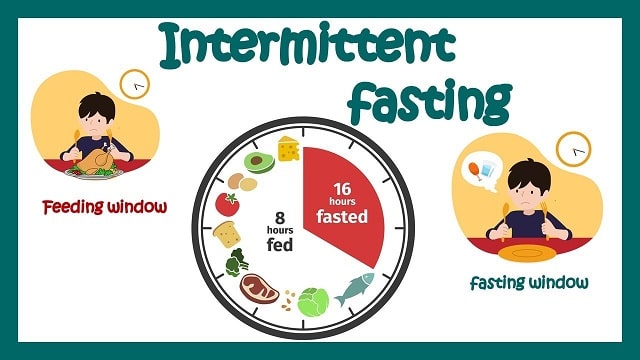Intermittent Fasting Diet
An intermittent fasting diet or fasting diet is a method of regulating eating patterns by implementing fasting for a certain time. However, you can still drink as usual.
Instead of using the term diet which refers to restricting or reducing food portions, this fasting method tends to focus more on regulating eating patterns and habits.
The intermittent fasting diet does not regulate the types of foods you need to limit or consume, but when you eat them and when to stop. Often, this form of diet recommends fasting for about 16 hours with a time that you can set yourself.
Benefits of Intermittent Fasting
In fact, fasting has many health benefits. This means that following an intermittent fasting diet also offers many good effects for the body, including:
1. Changing the function of hormones, genes, and cells
During fasting, there is an increase in growth hormone levels and a decrease in insulin levels. In addition, body cells also begin the process of regeneration and repair while changing the genes they need.
2. Eliminate belly fat and lose weight
An intermittent fasting diet also helps you consume fewer calories and increase metabolism even in small portions. However, of course, this has a positive effect on eliminating belly fat and weight loss.
3. Reduced risk of type 2 diabetes
In addition, this diet method also helps lower blood sugar in diabetics as well as reducing insulin levels. This means that fasting diets can also help lower blood sugar levels and the risk of insulin resistance, especially for men.
3. Improve brain function
Then, the intermittent fasting diet can help improve brain function. Because this diet method can support the formation of new nerves and protect the brain from the risk of damage.
4. Improve sleep quality
Another benefit that you should not miss from this diet technique is that it helps improve sleep quality. Because this diet also regulates the circadian rhythm which is very important in determining sleep patterns. A regular circadian rhythm certainly makes you able to wake up and sleep better.
Intermittent Fasting Diet Menu
Some intermittent fasting diet menus that you can try for breakfast, lunch, and dinner include:
Menu for beginners
For beginners, you can start a fasting diet with the following healthy menu.
- Breakfast: green smoothie at 8 am.
- Lunch: veggie burger at 12.00.
- Afternoon snack: cinnamon rolls fat bombs at 2:30 p.m.
- Dinner: salmon and vegetables at 17.30.
Intermittent fasting diet menu for middle age
If you have passed the initial stage, you can move up a level with the following intermediate phase menu.
- First meal: burger with mixed and processed avocado at 12.00.
- Snack: nuts and seeds menu at 14.30.
- Second meal: salmon and vegetables at 17.30.
Menu for advanced-level
Entering this phase, you can start fasting two days a week.
The food menu that you can consume when not fasting is vegetables, fruits, and lean meat. While when fasting, limit your calorie intake to no more than 700 calories.
You can eat snacks throughout the day, or you can eat lunch and dinner in moderate portions.
Don’t forget, to pay attention to your body’s fluid intake and make sure you don’t get dehydrated.
How to Do Intermittent Fasting Diet
There are several techniques that you can try in implementing an intermittent fasting diet according to the duration of the fast, including:
12 hour fast
The first is fasting for 12 hours a day, and eating normally. This method is quite good for beginners because the fasting duration is shorter with the same calorie intake.
Fasting for this duration can make the body convert reserve fat into energy. In addition, the body also releases ketones into the bloodstream which triggers weight loss.
16 hour fast
In addition, there is also a 16-hour fasting method with an 8-hour eating period or the 16:8 method. This 16-hour fasting duration is specifically for men, while the duration for women is only 14 hours.
Often, people who follow this diet method finish dinner at 8:00 p.m., then skip breakfast the next morning. As a result, they will only eat again at noon.
Intermittent fasting diet with 24-hour fasting a week
This method requires you to not eat for 24 hours on several days each week. For example, you finish eating from the last dinner until the next night.
After that, you can not fast for 24 hours fasting. Although it feels difficult, you can start it gradually. So, you don’t have to force yourself to fast for 24 hours straight.
Fasting two days a week
The last is the fasting diet method for two days in one week or 5:2. The method is to reduce calorie intake by 25 percent of the normal calorie count, around 500 to 600 calories or the same as one large meal. You can apply it twice a week without any sequence.
Possible Side Effects
Hunger is the main side effect of intermittent fasting. In addition, some people also feel weak and the brain may not function optimally as usual.
However, this condition may only be temporary. Because the body needs time to adapt to the new eating schedule.
Things to Note
Although safe, doctors will not recommend intermittent fasting for certain medical conditions. These conditions include:
- Suffering from or having a history of diabetes.
- Having impaired blood sugar levels and low blood pressure.
- Undergoing certain treatment or medication.
- Having a body mass index that is less than normal limits or having an eating disorder.
- Women who are in the pregnancy program.
- Experiencing excessive bleeding during menstruation for women.
- Pregnant and lactating mothers.
You also need to pay attention that food intake with sufficient nutritional needs as well as regular exercise are important keys to a healthy life and maintaining ideal body weight.

